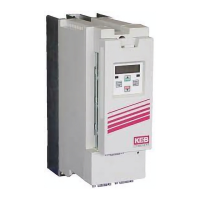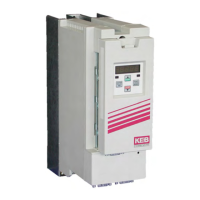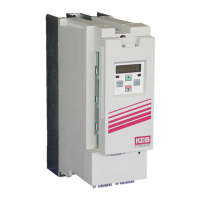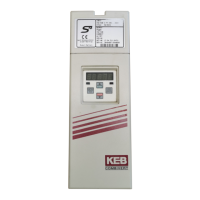11
4
311
KEB COMBIVERT F5-G / B
Name: Basis
04.12.01
4
CP - Parameter
© KEB Antriebstechnik, 2001
All Rights reserved
Operation
Chapter Section PageDate
Step frequency 1...3
Input I1
Input I2
Input I1 and I2
Three fixed frequencies can be adjusted. The fixed frequencies are selected with the
inputs I1 and I2.
Adjustment range: -400...400 Hz
Resolution: 0,0125 Hz
Factory settingCP.19: 5 Hz
Factory settingCP.20: 50 Hz
Factory settingCP.21: 70 Hz
If adjustments are made that are outside the fixed limits of CP.10 and CP.11, then the
frequency is internally limited. The negative values are released in application mode.
The rotation source of the fixed frequencies is not changed by CP.34, it always
corresponds to CP.34 = 2.
Adjustment range (depending on power circuit): 2 / 4 / 8 / 12 / 16 kHz
Factory setting: depending on power circuit
Note: Enter-Parameter
low switching frequency
• less inverter heating
• less discharge current
• less switching losses
• less radio interferences
• improved concentricity with low
speed
high switching frequency
• less noise development
• improved sine-wave simulation
• less motor losses
Carrier frequency The switching frequency with which the power modules are clocked can be changed
depending on the application. The employed power stage determines the maximum
switching frequency as well as the factory setting (see manual: part2). Refer to following
list to learn about influences and effects of the switching frequency.
At switching frequencies above 4 kHz pay absolute attention to the max.
motor line length in the technical data of the chapter 2.1.

